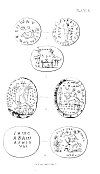
Sacred Texts Gnosticism Index Previous Next
Buy this Book at Amazon.com


The Gnostics and Their Remains, by Charles William King, [1887], at sacred-texts.com

Click to enlarge
Plate K
1. Circular copper plate, of the same size as the drawing, bearing the name of Aurelius Furellius, the person for whose benefit the talisman was devised. It represents a female figure, standing in the attitude of adoration; legend, "The Birth of Salvation." On the reverse is seen the Solar Lion bestriding a corpse, a type so frequent in this class that it may reasonably be referred to the entrance-rite of initiation, the "simulation of death" alluded to by Spartianus.
2. The most elegant of these mystic designs that has ever come to my knowledge. Two Cranes, one with the head of a Ram, the other of a Bull, stand guardians over the Mithraic sacramental table, under which lies crouched the Solar Lion, "the House of the Sun." Upon the table are set the sacred vessels; above it is the Delphic Ε, badge of Apollo, between two Palmyrene (?) letters, and over all the Seven Planets, engraved with an accuracy worthy of its elegance in a very fine sard.
3. A talisman of uncommon potency, to judge from the profusion of symbolism with which its two faces are overloaded. A four-winged, four-armed Power, standing like the Babylonian Belus in the air, is involved with a multiplicity of legends, amongst which the usual formulæ "Thou art our Father," "Sun of the Universe," "Michael," "Adonai," can clearly
be read. The reverse shows a female figure standing and adoring the Deity, who guides the Solar light. In the legends we can distinguish "Abraxas," "Michael," and "Michalo."
4. This type only differs from the last by the addition of the prostrate man under the Lion's feet, and that nothing definite can be made out of the disjointed inscription. The reverse merely bears the Great Name "Iao, Sabaoth," and the Seven Vowels. The potency of such words is still an article of faith with all true Jews. In the year 1835-6, the Rabbi of Neutra, in Hungary, actually stood his trial for murder on the charge of having cursed, by the "Ineffable Name" an enlightened lady whom he had ordered to leave the synagogue on the Sabbath-day, because she had ventured to make her appearance there with her hair in sight, and who had died suddenly on the very same day. The Rabbi only escaped conviction by publicly and solemnly disclaiming the possession of any such power, to the inexpressible disgust of his whole congregation, who looked upon him as a wretch that had denied his God in order to save his life!